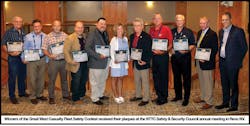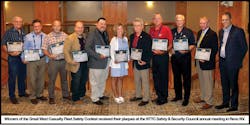Rollover prevention
REPRESENTATIVES from the Department of Transportation’s Volpe National Transportation Systems Center conducted a series of roundtable discussions during the National Tank Truck Carriers Safety & Security Council annual meeting June 12-14 in Reno, Nevada.
The roundtable discussions focused on human factors in cargo tank rollovers, as well as other insights on preventing rollovers. Volpe Center representatives termed the listening sessions as very productive.
“We gained some good insight,” said Becky Markunas, Volpe Center program analyst, safety measurement and analysis. “Previous studies have given us a lot of the ‘what,’ but not much of the ‘why.’ We want to do a better job of preventing rollovers, and that means we need a better understanding of the human factors associated with these events.
“Driver error was a factor in 67% of tank truck rollovers that occurred between 2011 and 2014. The largest percentage of those types of errors can be attributed to poor directional control, followed by overcompensation. The second most frequent driver error was in decision-making. In most cases, the driver was going too fast for conditions. However, many of them were traveling under the posted speed limit.
The largest number of cargo tank rollovers studied in the surveys occurred on roadways that were not divided. A high number of these events happened on straight stretches of roads, and the weather was clear most of the time.
While definitive data has not been collected, according to the Volpe report, it appears that the most effective technology for mitigating tank truck rollovers seems to be lane departure warning systems, as many of the rollovers in the Volpe dataset could be attributed to poor directional control (weaving and drifting).
The study speculated on the role played by distracted driving and fatigue. “We believe we have seen some potential indicators,” Markunas said. “That is one of the reasons we are doing field interviews.”
At the same time, the study states that “there does not appear to be a pattern of unsafe driving among tank truck operators in the study sample. Drivers had the same likelihood of rolling over regardless of whether they were involved in a previous crash.
One of the conclusions of the study is that more and better training is needed for truck drivers operating cargo tanks and hauling hazardous materials. Ingrid Bartinique, Volpe senior analyst, communications, operations research and analysis, said that smaller carriers need access to more training resources and less-experienced drivers need more cargo tank-specific training.
“We have concerns about the level of training at the smaller tank truck fleets,” Bartinique said. “The surveys showed that two-thirds of the rollovers involved tank trucks operated by carriers running fewer than 150 vehicles.”
The Volpe study recommended that the Federal Motor Carrier Safety Administration and the Pipeline and Hazardous Materials Safety Administration collaborate to develop a tank vehicle endorsement curriculum that includes guidelines for the use of the PHMSA/FMCSA Rollover Prevention Training Video. In addition, the study recommended that Section 8 Tank Vehicle in the model commercial driver license manual be redesigned to be less ambiguous.
Trainees should be provided with information relevant to tank vehicles in that section, rather than having to reference other sections of the manual. New entry level driver training programs for tank endorsements must cover rollover prevention methods, including vehicle design and performance considerations, load effects, highway factors, and driver factors.
The unique behavior of liquid tank cargo is a key factor in rollovers. The PHMSA tank vehicle driver training regulations specifically call out slosh, but make no mention of surge. The FMCSA final rule mentions neither slosh or surge by name.
All of this is classroom study. The same goes for the hazardous materials endorsement requirements. Each endorsement requires a written exam with just 10 questions. There is no behind-the-wheel skills test for these endorsements.
FMCSA reportedly expects training of pre-CDL drivers to be done with empty cargo tanks or non-tank vehicles. Implicitly, FMCSA expects industry to train drivers post-CDL on the safe operation and handling of cargo tank vehicles.
“Given that post-CDL training of tank truck drivers is not regulated, and that there is neither a model nor required curriculum for employers to follow, does this have an impact on safety?” the Volpe researchers as those attending the NTTC conference.
“We’re also asking about the impact of driver fatigue and distraction on safety,” Bartinique said. “If you are not paying attention, bad things happen. Our interviews at this meeting suggested that driver distraction is becoming a bigger and bigger problem.”

